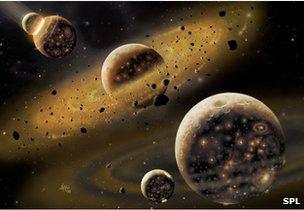Moon formation: New spins put on old questions
- Published

The impact is supposed to have thrown debris into space that then coalesced into a satellite
Scientists have put a new turn on the theory of how the Moon was created.
It has long been thought that the lunar body resulted from an impact between the early Earth and another planet-sized object 4.5 billion years ago.
But this theory predicts Earth and its satellite should have a quite different chemical make-up - and the data shows in fact they are very similar.
Now, new modelling reveals that if the Earth had a much faster spin before the impact, the theory fits the chemistry.
It is one idea to fix the composition conundrum explored in two papers published this week by the journal Science.
The giant impact hypothesis was first posited in the 1970s. It holds that the Moon formed from the debris kicked into orbit by the collision of a smaller proto-planet with the infant Earth.
But the early models indicated that much of this debris would have originated from the impactor, whose composition would most probably have differed substantially from that of Earth.
This is not reflected in the analysis of Earth and Moon rocks – for example, their oxygen isotope, or atom type, compositions are identical.
Matija Cuk, from the Seti Institute, and colleagues, external ran new simulations in which the early Earth was rotating on its axis in just a few hours prior to the impact - compared to the present 24 hours.
In such a scenario, the team could get debris material thrown into a Moon-forming disc around the Earth that had the right chemical make-up. In other words, it was substantial Earth material from its mantle that was ejected in the collision.
After the impact, the gravitational interaction between the Sun and the Moon could then have slowed the fast rotation of the Earth to the speed we now experience.
Robin Canup from the Southwest Research Institute (SwRI) and colleagues, external took a different approach.
Their simulations involved larger impactors hitting an Earth of comparable size and at comparatively lower speeds. Again, the team was able to produce a Moon with the same chemical composition as the Earth.
- Published27 July 2012
- Published1 January 2012
- Published3 August 2011
- Published1 February 2011